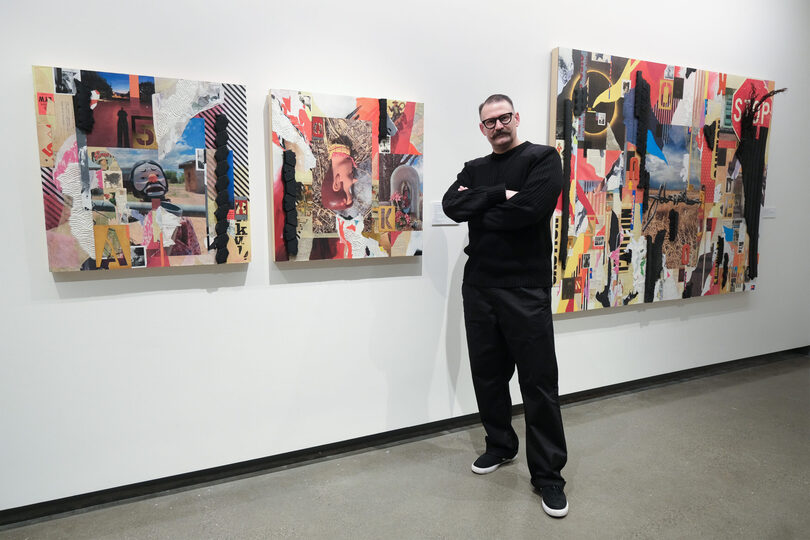‘No Roses in December’ unveils the ‘ghosts’ that live with us

Maxine Brackbill | Photo Editor
Through his mixed-media art, artist David Edward Johnson illustrates his father’s memory loss. His exhibition, “No Roses in December,” will be on display until Mar. 31.
Get the latest Syracuse news delivered right to your inbox.
Subscribe to our newsletter here.
Mixed-media artist David Edward Johnson believes in ghosts. The artist’s new piece, “No Roses in December,” displayed in Syracuse’s Everson Art Museum, reflects the ghosts of his father’s flitting memory as he experiences the effects of late-stage Alzheimer’s disease.
“This series is really about capturing (my father’s) experience,” Johnson said. “It was about capturing the shards of broken memory.”
“No Roses in December,” a collection of eight mixed-media collage works centered on desire, identity, loss and the American Dream, debuted at the Everson on Jan. 27 and is on display until Mar. 31. Johnson’s father was diagnosed with Alzheimer’s 15 years ago, and cannot attend the exhibit because of the progression of his memory loss.
“It’s a shame that he can’t (attend the exhibit), because I would love to share this with him,” Johnson said. “(My mom seeing the exhibit has) been gratifying. Even if (my dad) can’t, somebody who was very close to the process was able to see and understand it.”
Based in Skaneateles, NY, Johnson creates his art to illustrate the “ghosts” we live with every day. Each piece in “No Roses in December” blends original photography and “found objects,” coming together to portray his dad’s Alzheimer’s. Johnson culled the final selection of 16 photographs from a pool of 1,000.
Set in West Texas, the photographs share glimpses of lost life in the desert heat. Fragments of forgotten adobes and abandoned possessions hint at a landscape once abundant with activity.
“We have these vestal remains — these things left on the landscape,” Johnson said. “It was a pretty perfect metaphor for my dad’s experience.”
Art curator Steffi Chappell, whose own grandfather suffered from dementia, helped select Johnson for a solo showing at the museum. Johnson’s art struck a chord with Chappell because of the vivid imagery and ability to create far-reaching emotional connections.
Johnson created this art for himself and for his father, but also to identify with his audience. Viewers reach out to Johnson with stories of uncles, fathers, mothers and grandparents who share his experience.
“It’s something that a lot of people have dealt with, either directly or indirectly,” Chappell said. “It speaks to a lot of people, and it’s something that a lot of people can relate to.”
Manuel Matias, a museum visitor, was surprised by the “found objects” Johnson included to transform the one-dimensional piece into a tactile three-dimensional piece.
“I would love to run my hands through all of his pieces,” Matias said. “The texture, to me, is completely different (from most art pieces).”
On Wednesday, Johnson spoke at the Everson and unveiled “Division,” a new, large-scale piece taken from the nearly 1,000 photographs that hadn’t been selected for the original eight pieces.
“Right away, it just hit me. It took me to my childhood,” Sylvie Prendergast, SU alum and museum-goer said. “It’s time passing, it’s traveling. I see it as a metaphor for life.”
Upon walking through Johnson’s exhibit, Johnson’s wife, Stephanie Johnson, cried. She supported her husband every step of the way through the creation of “No Roses in December.” From shooting photos in Texas, to watching him work in the studio, she said she loved being a part of the art.
Through the process of his father’s diagnosis and the progressive loss of his memory, Johnson has used art as a method of communication. He considers his audience and the message he wants to convey to them while he creates, Johnson said.
“The desire to create is not really a choice. It’s a need. It makes me feel complete,” Johnson said. “It makes me feel happy.”





